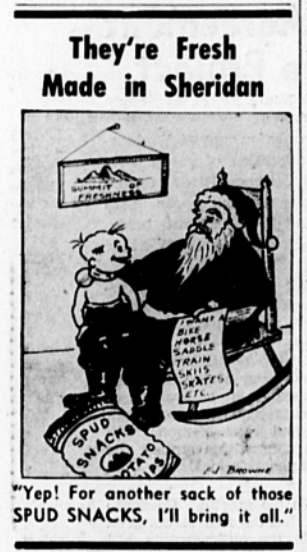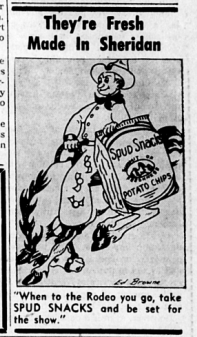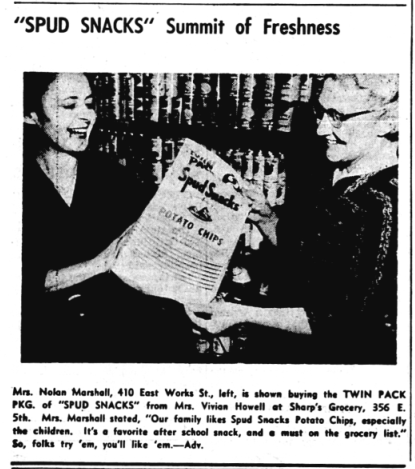Who Remembers Spud Snacks? A Nostalgic Look at Sheridan's Iconic Chip Company
- Michael Dykhorst
- Aug 21, 2024
- 7 min read
On the "Judy Armstrong's Memories of Sheridan" Facebook group, there are numerous posts about Spud Snacks, the potato chip company from Sheridan. I thought it would be fun to explore the history of the company, especially since I have a small cookbook featuring recipes that use their chips.

If you grew up in Sheridan, Wyoming, you might remember a local favorite that brought crispy joy to many: Spud Snacks. What began with equipment originally purchased by Harry C. Hon and eventually found its home at 1105 Leopard Street became a beloved part of the community’s fabric.
A Taste of Sheridan’s History
Spud Snacks began with a twist of fate and a bit of entrepreneurial spirit. Harry C. Hon, a fireman with a passion for food, harbored a dream of making potato chips. At some point in his early career, he purchased specialized equipment designed for chip production. However, life took an unexpected turn when Harry decided to enlist in the U.S. Army, committing himself to serve his country. With his new military duties, the equipment, and his potato chip ambitions were shelved, quite literally. The machinery was stored away, gathering dust as years passed and Harry's life moved in a different direction.
It wasn’t until June 24, 1953, that the dormant dream found new life. Mary Austin, a resourceful woman with a knack for seeing potential where others saw disuse, acquired the forgotten equipment.
Mary wasn’t just purchasing machinery; she was reigniting a vision. In her garage at 860 West Loucks, she began experimenting with the chip-making process, tweaking recipes, and perfecting the art of potato chips. What had started as a fireman’s side interest, and then a forgotten venture, was now becoming a burgeoning business under Mary’s dedicated hands. Her garage soon filled with the enticing aroma of fresh, crispy chips, and Spud Snacks was born, ready to carve out its place in the world.
Above: Three Advertisements Mary Austin Placed in the Sheridan Press
Mary Austin sold the equipment at auction just a year and two months after she began production, the reason was cited as age and health reasons.
A New Era
On August 30, 1954, Mary Fugate made a bold move that would change her life forever—she purchased the potato chip-making equipment at auction. Though she had no background in the food industry, let alone the intricacies of potato chip production, Mary was undeterred. Her determination to succeed was matched by her willingness to learn. Seeking advice from more experienced chip-makers in Casper and Billings, she absorbed their knowledge, turning herself into a skilled artisan of the craft.
The work that lay ahead was anything but easy. The equipment Mary had acquired was entirely manual, requiring not just skill but also significant physical effort. Each day, with the help of just two employees, Mary would transform roughly 200 pounds of raw potatoes into crispy, golden chips. The process was meticulous: the potatoes were first peeled using an automatic peeler—a small relief in the otherwise hands-on operation. They were then carefully sliced by hand, ensuring each chip was the right thickness. After slicing, the potato slices were soaked in water to remove excess starch, a critical step in achieving the perfect texture.
Once soaked, the slices were transferred to an ordinary clothes dryer, that was repurposed to spin away the excess water. This was followed by the frying process, where the chips were immersed in a vat of hot oil. Mary or one of her employees would hand-stir the chips to ensure even cooking, a labor-intensive task that demanded constant attention. Once fried to perfection, the chips were drained on a steel table, hand-salted while still warm, and left to cool. The final steps were just as manual: the cooled chips were weighed on a small scale, and each batch was carefully hand-sealed in its packaging.
What Mary Fugate lacked in experience, she made up for in perseverance and a commitment to quality. Her journey into the world of potato chips was marked by hard work, learning, and the hands-on process that turned simple potatoes into the beloved Spud Snacks.
From Garage to Factory on Leopard Street
In the early days, her role extended far beyond the production line. Once the chips were hand-sealed and ready for sale, Mary would load them into the back of her pickup truck and hit the road, personally delivering them to local stores and markets. Her direct, hands-on approach not only helped build relationships with her customers but also allowed her to ensure that every bag of chips met the high standards she had set.
As word spread and the demand for Spud Snacks grew, it became clear that the operation had outgrown its modest garage setup. In 1958, the business took a significant leap forward with the construction of a dedicated factory at 1105 Leopard Street. This new facility marked a turning point for Spud Snacks, as it was equipped with semi-automatic machinery that could handle a larger volume of production. The upgrade allowed Mary to focus more on expanding the business rather than managing the day-to-day manual labor.
The factory's success led to further growth, and by 1957, an extension was added to accommodate fully automated operations. This transition to automation was a game-changer, significantly increasing the production capacity and efficiency of Spud Snacks. The once labor-intensive process now benefited from modern technology, allowing the company to keep up with the rising demand and distribute the chips to a wider market.
The quality of Spud Snacks was always a top priority for Mary, and that started with the potatoes themselves. Initially, she sourced Kennibec and Cobbler potatoes from a trusted grower in Powell, Wyoming, known for producing the perfect potatoes for chip-making. These varieties were prized for their texture and flavor, essential qualities for creating the ideal chip. However, when attempts to grow these potatoes closer to Sheridan proved unsuccessful due to the region's unsuitable climate, Mary faced a new challenge.
Undeterred, she began sourcing potatoes from further afield. As the Powell supply dwindled, Spud Snacks started receiving shipments from states like Arizona, Florida, California, and North Dakota. Each region offered its own unique conditions for potato farming, ensuring that Spud Snacks could maintain the high quality of their chips despite the changing sources. This adaptability was a testament to Mary's commitment to excellence and her ability to navigate the complexities of running a growing business.
Through every stage of Spud Snacks' evolution, Mary Fugate remained deeply involved, ensuring that the spirit of the company—rooted in hard work, quality, and a personal touch—was never lost. From the early days of hand-stirring chips in a garage to overseeing a fully automated factory, Mary’s journey was one of resilience and relentless dedication.

End of an Era
Even though Spud Snacks is no longer in business, having closed its doors in the 1960s, due to the high cost of shipping both potatoes and oil becoming too burdensome, its legacy continues to resonate with those who remember it. The brand wasn’t just about making potato chips—it was about creating memories that have lasted long after the final bag was sealed. For many in Sheridan and the surrounding areas, Spud Snacks became a symbol of good times shared with family and friends.
In its heyday, Spud Snacks was known not just for its chips but for its efforts to engage with the community in creative ways. One of the most memorable of these was the release of a small cookbook that invited customers to see their favorite snack in a new light. The cookbook was a testament to the versatility of Spud Snacks, featuring inventive recipes that transformed the humble potato chip into a key ingredient in a variety of dishes. Recipes like "Corned Beef and Chip Casserole" and "Easiest-of-all Fried Chicken" became instant favorites, showcasing how Spud Snacks could be used in both savory and sweet creations. The cookbook wasn’t just a collection of recipes—it was a piece of Sheridan’s culinary history, capturing the spirit of the time and the ingenuity of home cooks who found new ways to enjoy a beloved product. Though this cookbook is rare, it became a cherished item passed down through generations.
Even though the factory at 1105 Leopard Street no longer hums with activity, and the chips are no longer made, the impact of Spud Snacks endures in the memories of those who grew up with it.
The closure of Spud Snacks marked the end of an era, but the brand’s influence can still be felt. It lives on in the stories people tell, in the nostalgic longing for the simple pleasure of those chips.
Remembering Spud Snacks
For those who remember Spud Snacks, it’s more than just a brand—it’s a part of Sheridan’s history. From its early days in a garage on Loucks Street to its heyday on Leopard Street, Spud Snacks left an indelible mark on the community. Whether you were a lifelong resident or just passing through, if you had the chance to enjoy a bag of Spud Snacks, you were tasting a piece of Sheridan’s heritage.
And if you were lucky enough to get your hands on that special cookbook, you know that Spud Snacks wasn’t just about eating chips straight out of the bag—it was about creating something even more delicious. Spud Snacks will always hold a special place in the community's heart, taste buds, and, for some, this recipe collection.

Recipe Book from the collection of Michael Dykhorst
Spud Snacks' connection to the community extended beyond just being a popular snack; it was also a fixture in the local high school yearbook for several years. The brand's advertisements in the yearbook featured not only the chips but also highlighted local students, making them part of the Spud Snacks legacy. These ads were more than just marketing—they were a celebration of the town's youth and a reflection of the pride the community felt in its homegrown brand.
CLICK ON PHOTOS TO ENLARGE
Other various Advertisements 1955 -1967: - Ads drawn by someone with the last name of White, Dave Siebert and Ed Browne.








































































Comments